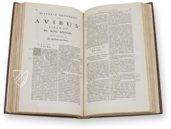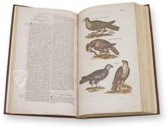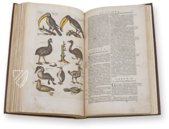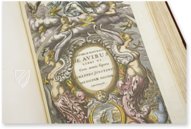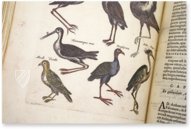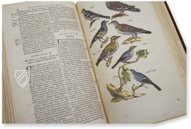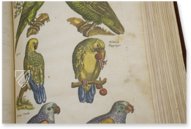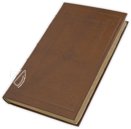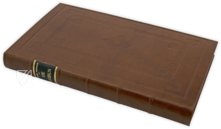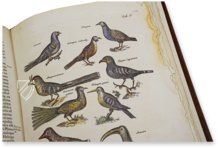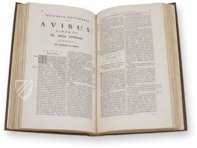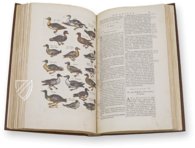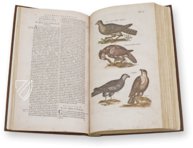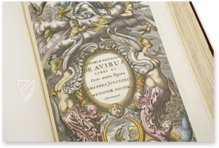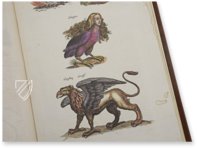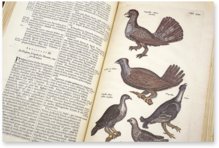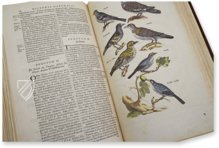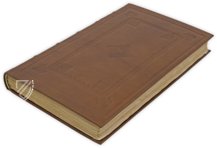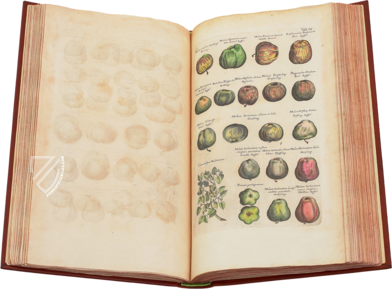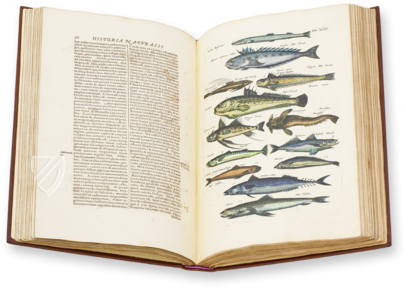Historia Naturalis: De Avibus
(3,000€ - 7,000€)
The wonderful, illustrated Book of Birds was a widely disseminated bestseller of the 17th century. It represents a volume of the five-volume Historia Naturalis of John Jonston. The Polish doctor and Renaissance man composed an encyclopedic overview for the history of animals, which was considered to be the standard work of zoology for a century. The series manifested in the years 1650–1653 in the publishing house of Matthäus Merian the Elder in Frankfurt am Main and experienced numerous translations and new editions. The success of the Historia Naturalis is particularly based on its illustrations from the hand of Matthäus Merian the Younger that were grandiose, loving, and simultaneously claimed to be scientific. Moreover, in the volume at hand of the Historia Naturalis de Avibus – the overview work for all kinds of birds – these copperplate engravings are magnificently colored.
Historia Naturalis: De Avibus
The wonderful, illustrated Book of Birds was a widely disseminated bestseller of the 17th century. It represents a volume of the five-volume Historia Naturalis of John Jonston. The Polish doctor and Renaissance man composed an encyclopedic overview for the history of animals, which was considered to be the standard work of zoology for a century. The series manifested in the years 1650–1653 in the publishing house of Matthäus Merian the Elder in Frankfurt am Main and experienced numerous translations and new editions. The success of the Historia Naturalis is particularly based on its illustrations from the hand of Matthäus Merian the Younger that were grandiose, loving, and simultaneously claimed to be scientific. Moreover, in the volume at hand of the Historia Naturalis – the overview work for all kinds of birds – these copperplate engravings are magnificently colored.
Avis: Blackbird, Cockatoo, and Phoenix
Countless birds and other winged animals bustle about colorfully on the 62 copperplate engravings of the total of 227 pages of the Historia Naturalis de Avibus. The beholder and reader is informed about splendid peacocks, numerous domestic birds, but also exotic and sometimes curious or fantastical animals such as a penguin or a phoenix. The encyclopedic overview work is subdivided into individual chapters, e.g. vultures, falcons, parrots, ravens, owls, chickens and geese, ducks and waterfowl. Among the Avis, Latin for bird, all winged creatures were then counted, including bats among others. Similar to a medieval bestiary, included successively alongside real animals were also such fantastical creatures as phoenixes, harpies, and winged lions from Greek mythology – naturally with a wink in the 17th century. The volume thus offers a wonderful glimpse in the first attempts at a science of animals!
A Tireless Teacher
The famous writer of the Historia Naturalis was John Jonston (1603–1675) of Poland. The unusual named belies his Scottich heritage. Jonston’s primary occupation was as a doctor, but he nonetheless busied himself with countless disciplines and sciences and can therefore be described as a Renaissance man. As a tutor and tour guide he transmitted his knowledge to young noblemen. Nevertheless, Jonston was famous because of his scientific-pedagogical writings on such manifold themes as child-rearing, philosophy and theology, history, but also medicine or minerology, with the famous Historia Naturalis in five volumes leading the way. With his writings, Jonston intended to make the collected knowledge of the time accessible.
An Encyclopedia of Animals
For his incomplete magnum opus, Jonston planned a comprehensive illustrated depiction of the world of animals, plants, and people. The five volumes about the world of animals, with the title of Historia Naturalis Animalium, was printed from 1650 to 1653 in the publishing house of Matthäus Merian the Younger, who had taken over the famous atelier of his father Matthäus Merian the Elder, in Frankfurt am Main. He was also responsible as a copperplate engraver as well as for the artistic design of the editions. He learned his craft from such famous names as Joachim von Sandrart and Anthonis van Dyck. The marvelous illustrations, colorfully illustrated moreover, lend the sophisticated publication its final touches and are surely a reason for the exceptional popularity of the Historia Naturalis across Europe.
Codicology
- Size / Format
- 300 pages / 38.0 × 22.0 cm
- Origin
- Netherlands
- Date
- 1657
- Epochs
- Style
- Language
- Illustrations
- 62 copperplate engravings
- Artist / School
- Johannes Jonstonus (John Jonston) (1603–1675) (author)
Matthaeus Merian The Younger (1621–1687) (engraver)
Historia Naturalis: De Avibus
Partridges
The top half of this page shows four different types of partridge. A so-called Perdix rußa” or “Russian partridge” is found in the upper left corner, probably the Daurian partridge. Moving clockwise, we see a grey partridge identified in both Latin and German, a rock partridge identified in Greek and German, and finally a so-called *Perdix Damasceaa that likely originated from the region around Damascus. All of these colored woodcuts are remarkable for their artistry and naturalism.
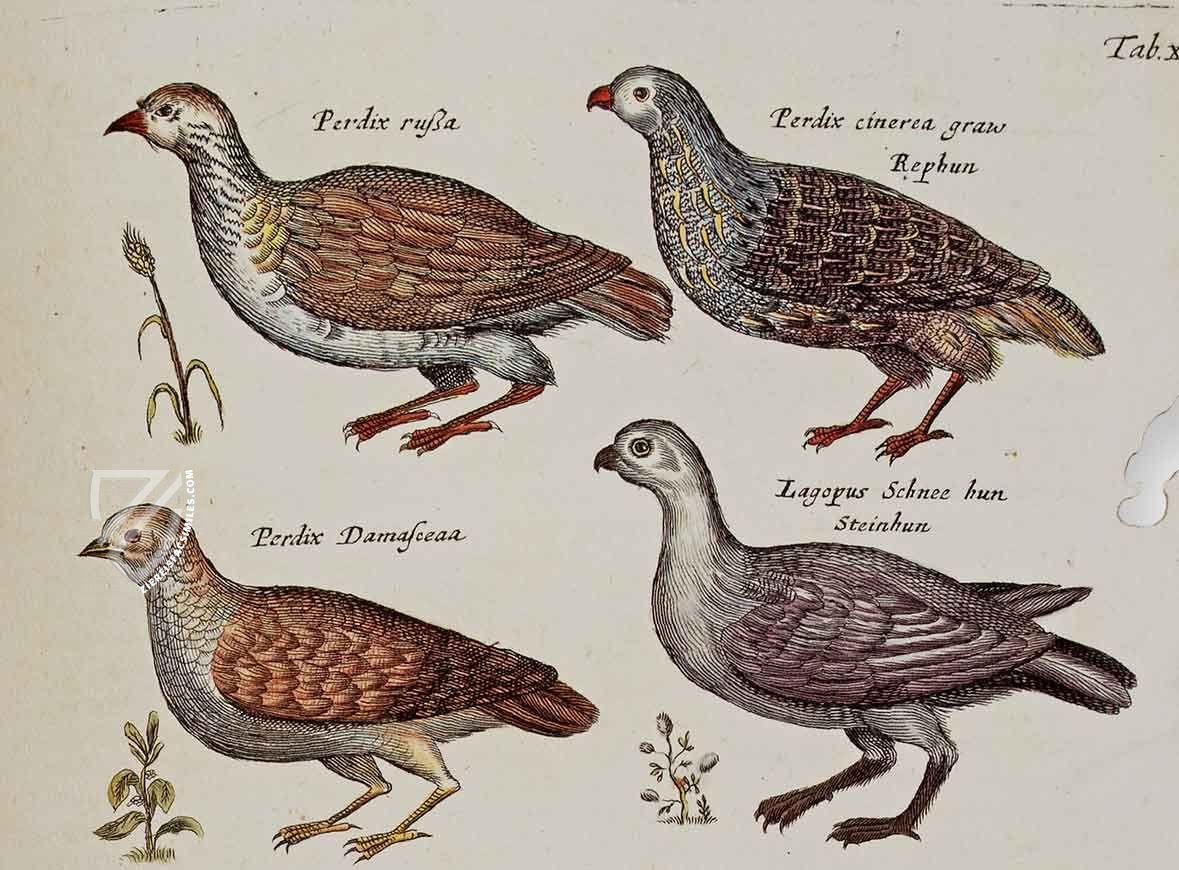
Historia Naturalis: De Avibus
Golden Eagle
Here we have the most widely distributed species of eagle in the world and one of the largest – the golden eagle, Aquila chrysaetos. It is presented above in profile with its wing extended and a piercing gaze extending to some unknown target. Below, the eagle grasps the severed head of its prey in its right claw as it grooms its feathers with its beak.
Aside from the artistry and realism with which the feathers and other features of the golden eagle are depicted, its impressive talons are presented in detail and identified in German. The Golden eagle is distinguished by its long, impressive hallux-claw (hind claw), which is even longer than that of a bald eagle and second only to that of the massive harpy eagle.
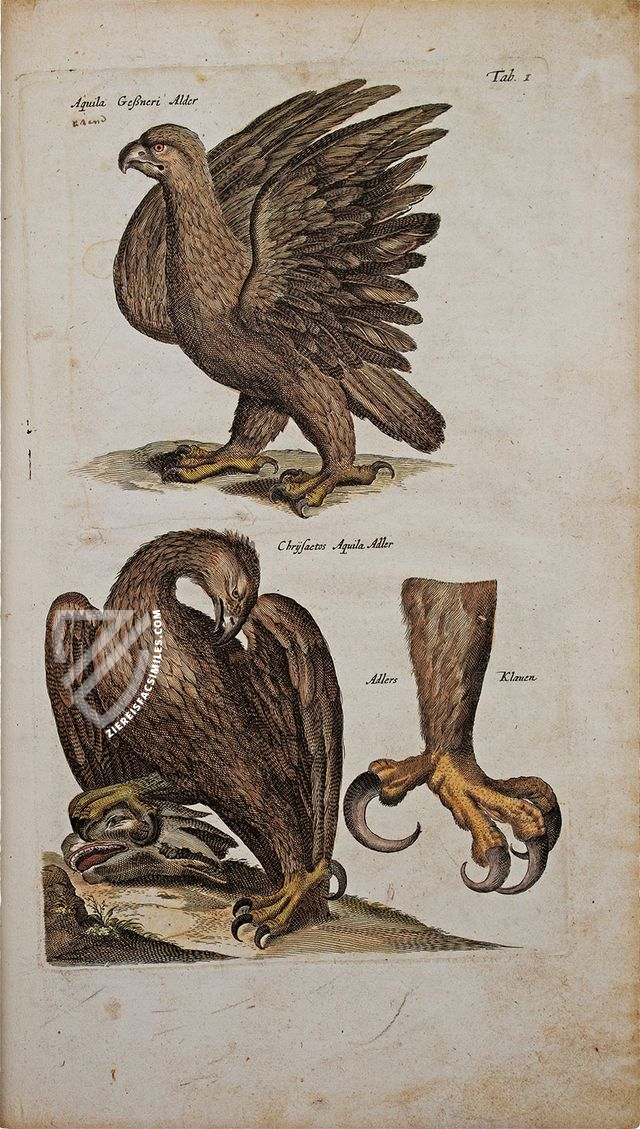
#1 Historia Naturalis: De Avibus
Language: Spanish
(3,000€ - 7,000€)
- Treatises / Secular Books
- Apocalypses / Beatus
- Astronomy / Astrology
- Bestiaries
- Bibles / Gospels
- Chronicles / History / Law
- Geography / Maps
- Saints' Lives
- Islam / Oriental
- Judaism / Hebrew
- Single Leaf Collections
- Leonardo da Vinci
- Literature / Poetry
- Liturgical Manuscripts
- Medicine / Botany / Alchemy
- Music
- Mythology / Prophecies
- Psalters
- Other Religious Books
- Games / Hunting
- Private Devotion Books
- Other Genres
- Afghanistan
- Armenia
- Austria
- Belgium
- Colombia
- Croatia
- Cyprus
- Czech Republic
- Denmark
- Egypt
- Ethiopia
- France
- Germany
- Greece
- Hungary
- India
- Iran
- Iraq
- Israel
- Italy
- Japan
- Lebanon
- Luxembourg
- Mexico
- Morocco
- Netherlands
- Palestine
- Peru
- Poland
- Portugal
- Russia
- Serbia
- Spain
- Sri Lanka
- Sweden
- Switzerland
- Syria
- Turkey
- Ukraine
- United Kingdom
- United States
- Uzbekistan
- Aboca Museum
- Ajuntament de Valencia
- Akademie Verlag
- Akademische Druck- u. Verlagsanstalt (ADEVA)
- Aldo Ausilio Editore - Bottega d’Erasmo
- Alecto Historical Editions
- Alkuin Verlag
- Almqvist & Wiksell
- Amilcare Pizzi
- Andreas & Andreas Verlagsbuchhandlung
- Archa 90
- Archiv Verlag
- Archivi Edizioni
- Arnold Verlag
- ARS
- Ars Magna
- ArtCodex
- AyN Ediciones
- Azimuth Editions
- Badenia Verlag
- Bärenreiter-Verlag
- Belser Verlag
- Belser Verlag / WK Wertkontor
- Benziger Verlag
- Bernardinum Wydawnictwo
- BiblioGemma
- Biblioteca Apostolica Vaticana (Vaticanstadt, Vaticanstadt)
- Bibliotheca Palatina Faksimile Verlag
- Bibliotheca Rara
- Boydell & Brewer
- Bramante Edizioni
- Bredius Genootschap
- Brepols Publishers
- British Library
- C. Weckesser
- Caixa Catalunya
- Canesi
- CAPSA, Ars Scriptoria
- Caratzas Brothers, Publishers
- Carus Verlag
- Casamassima Libri
- Chavane Verlag
- Christian Brandstätter Verlag
- Circulo Cientifico
- Club Bibliófilo Versol
- Club du Livre
- CM Editores
- Collegium Graphicum
- Collezione Apocrifa Da Vinci
- Comissão Nacional para as Comemorações dos Descobrimentos Portugueses
- Coron Verlag
- Corvina
- CTHS
- D. S. Brewer
- Damon
- De Agostini/UTET
- De Nederlandsche Boekhandel
- De Schutter
- Deuschle & Stemmle
- Deutscher Verlag für Kunstwissenschaft
- DIAMM
- Droz
- E. Schreiber Graphische Kunstanstalten
- Ediciones Boreal
- Ediciones Grial
- Ediclube
- Edições Inapa
- Edilan
- Editalia
- Edition Deuschle
- Edition Georg Popp
- Edition Leipzig
- Edition Libri Illustri
- Editiones Reales Sitios S. L.
- Éditions de l'Oiseau Lyre
- Editions Medicina Rara
- Editorial Casariego
- Editorial Mintzoa
- Editrice Antenore
- Editrice Velar
- Edizioni Edison
- Egeria, S.L.
- Eikon Editores
- Electa
- Emery Walker Limited
- Enciclopèdia Catalana
- Eos-Verlag
- Ephesus Publishing
- Ernst Battenberg
- Eugrammia Press
- Extraordinary Editions
- Fackelverlag
- Facsimila Art & Edition
- Facsimile Editions Ltd.
- Facsimilia Art & Edition Ebert KG
- Faksimile Verlag
- Feuermann Verlag
- Folger Shakespeare Library
- Franco Cosimo Panini Editore
- Friedrich Wittig Verlag
- Fundación Hullera Vasco-Leonesa
- G. Braziller
- Gabriele Mazzotta Editore
- Gebr. Mann Verlag
- Gesellschaft für graphische Industrie
- Getty Research Institute
- Giovanni Domenico de Rossi
- Giunti Editore
- Graffiti
- Grafica European Center of Fine Arts
- Guido Pressler
- Guillermo Blazquez
- Gustav Kiepenheuer
- H. N. Abrams
- Harrassowitz
- Helikon
- Hendrickson Publishers
- Henning Oppermann
- Herder Verlag
- Hes & De Graaf Publishers
- Hoepli
- Holbein-Verlag
- Hortus Deliciarum
- Houghton Library
- Hugo Schmidt Verlag
- Idion Verlag
- Il Bulino, edizioni d'arte
- ILte
- Imago
- Insel Verlag
- Instituto Nacional de Antropología e Historia
- Istituto dell'Enciclopedia Italiana - Treccani
- Istituto Ellenico di Studi Bizantini e Postbizantini
- Istituto Geografico De Agostini
- Istituto Poligrafico e Zecca dello Stato
- Italarte Art Establishments
- J. Thorbecke
- Jan Thorbecke Verlag
- Johnson Reprint Corporation
- Josef Stocker
- Josef Stocker-Schmid
- Jugoslavija
- Karl W. Hiersemann
- Kasper Straube
- Kaydeda Ediciones
- Kindler Verlag / Coron Verlag
- Kodansha International Ltd.
- Konrad Kölbl Verlag
- Kurt Wolff Verlag
- La Liberia dello Stato
- La Linea Editrice
- La Meta Editore
- Lambert Schneider
- Landeskreditbank Baden-Württemberg
- Leo S. Olschki
- Les Incunables
- Library of Congress
- Libreria Musicale Italiana
- Lichtdruck
- Lito Immagine Editore
- Lumen Artis
- Lund Humphries
- M. Moleiro Editor
- Maison des Sciences de l'homme et de la société de Poitiers
- Manuscriptum
- Martinus Nijhoff
- Maruzen-Yushodo Co. Ltd.
- MASA
- McGraw-Hill
- Militos
- Millennium Liber
- Müller & Schindler
- Nahar and Steimatzky
- National Library of Wales
- Neri Pozza
- Nova Charta
- Oceanum Verlag
- Odeon
- Orbis Mediaevalis
- Orbis Pictus
- Österreichische Staatsdruckerei
- Oxford University Press
- Pageant Books
- Parzellers Buchverlag
- Patrimonio Ediciones
- Pattloch Verlag
- PIAF
- Pieper Verlag
- Plon-Nourrit et cie
- Prestel Verlag
- Princeton University Press
- Prisma Verlag
- Priuli & Verlucca, editori
- Pro Sport Verlag
- Propyläen Verlag
- Pytheas Books
- Quaternio Verlag Luzern
- Reales Sitios
- Recht-Verlag
- Reichert Verlag
- Reichsdruckerei
- Riehn & Reusch
- Roberto Vattori Editore
- Rosenkilde and Bagger
- Roxburghe Club
- Salerno Editrice
- Sarajevo Svjetlost
- Schöck ArtPrint Kft.
- Scolar Press
- Scrinium
- Scripta Maneant
- Scriptorium
- Siloé, arte y bibliofilia
- SISMEL - Edizioni del Galluzzo
- Sociedad Mexicana de Antropología
- Société des Bibliophiles & Iconophiles de Belgique
- Soncin Publishing
- Sorli Ediciones
- Stainer and Bell
- Studer
- Styria Verlag
- Sumptibus Pragopress
- Szegedi Tudomànyegyetem
- Taberna Libraria
- Tarshish Books
- Taschen
- Tempus Libri
- Testimonio Compañía Editorial
- Thames and Hudson
- The Clear Vue Publishing Partnership Limited
- The Facsimile Codex
- The Folio Society
- The Marquess of Normanby
- The Richard III and Yorkist History Trust
- Tip.Le.Co
- TouchArt
- TREC Publishing House
- TRI Publishing Co.
- Trident Editore
- Typis Regiae Officinae Polygraphicae
- Union Verlag Berlin
- Universidad de Granada
- University of California Press
- University of Chicago Press
- Urs Graf
- Vallecchi
- Van Wijnen
- VCH, Acta Humaniora
- VDI Verlag
- VEB Deutscher Verlag für Musik
- Verlag Anton Pustet / Andreas Verlag
- Verlag Bibliophile Drucke Josef Stocker
- Verlag der Münchner Drucke
- Verlag für Regionalgeschichte
- Verlag Styria
- Vicent Garcia Editores
- W. Turnowsky
- Waanders Printers
- Wiener Mechitharisten-Congregation (Wien, Österreich)
- Wissenschaftliche Buchgesellschaft
- Wydawnictwo Dolnoslaskie
- Xuntanza Editorial
- Zakład Narodowy
- Zollikofer AG








